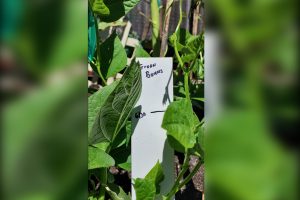Gardening takes patience and persistence. Does gardening teach patience? Or does it illuminate how little patience we have? Exercises in patience include prepping soil before planting; waiting in the spring for the last frost date so that young plants will have a good chance of survival; or, in the case of peppers, waiting to plant until soil temperature is 70 degrees.
Now that plants are in the ground, and watering schedules are set, the wait begins. If you garden as I do, you are out there every day checking for possible problems and growth. Earwigs bit off all the squash plants the day after they were planted! Tomatoes seemed to be just sitting there. I experience impatience when it looks like green beans are sitting still with their 4 or 5 leaves, or the basil is 3 inches high and not moving, Jotting down plant names and dates planted will provide a way to check on days to maturity for each type of plant and set reasonable expectations.
This year I’m playing around with visual aids. I inserted wood stakes near select plants. Then, using a marking pen, I drew height lines (much as I did as my children were growing up). I marked the date on the stake and repeated the process in a week. That way I could see results!
Years ago, we planted my all-time favorite, grape vines. Starting out with a stick in the ground (the grape cutting), it looked like nothing would come of this. But once leaves appeared, we could measure on a daily basis. Vines grew 3-4 inches in a day!
Regarding persistence, the earwig problem continues, but placing rolled up newspaper under plants that are suffering can help, Check the newspaper rolls each morning, dumping any earwigs into a bucket of soapy water. It’s surprising how effective this can be. Diatomaceous earth sprinkled around young plants will help. And an empty tuna or cat food can with a little oil and a little soy sauce placed near the plants is surprisingly effective (and satisfying).
Growing up, we gardened with my mother and watched as she patiently worked the soil, planted, watered and weeded. I don’t recall her lamenting about how long something was taking. She took it all in stride; her experience told her that our garden would produce. Talking with others and sharing ideas, listening and learning helps us, as well as our gardens, grow. You find that you are not unique in your struggles and successes.
Working with children and young gardeners, it often helps to plant things that germinate and grow quickly. It acknowledges that need to see progress while teaching the reward of waiting and noticing. Things like radishes, sunflowers, and runner beans give a sense of accomplishment and encouragement. Patience and pausing to appreciate the earth, soil, and plants are healthy and needful practices. We can’t make plants grow, but we can nurture them with healthy soil, water, planting in good conditions, and stepping back to watch and enjoy.
Nancy Bliss is a University of California Cooperative Extension Master Gardener of Tuolumne County.

